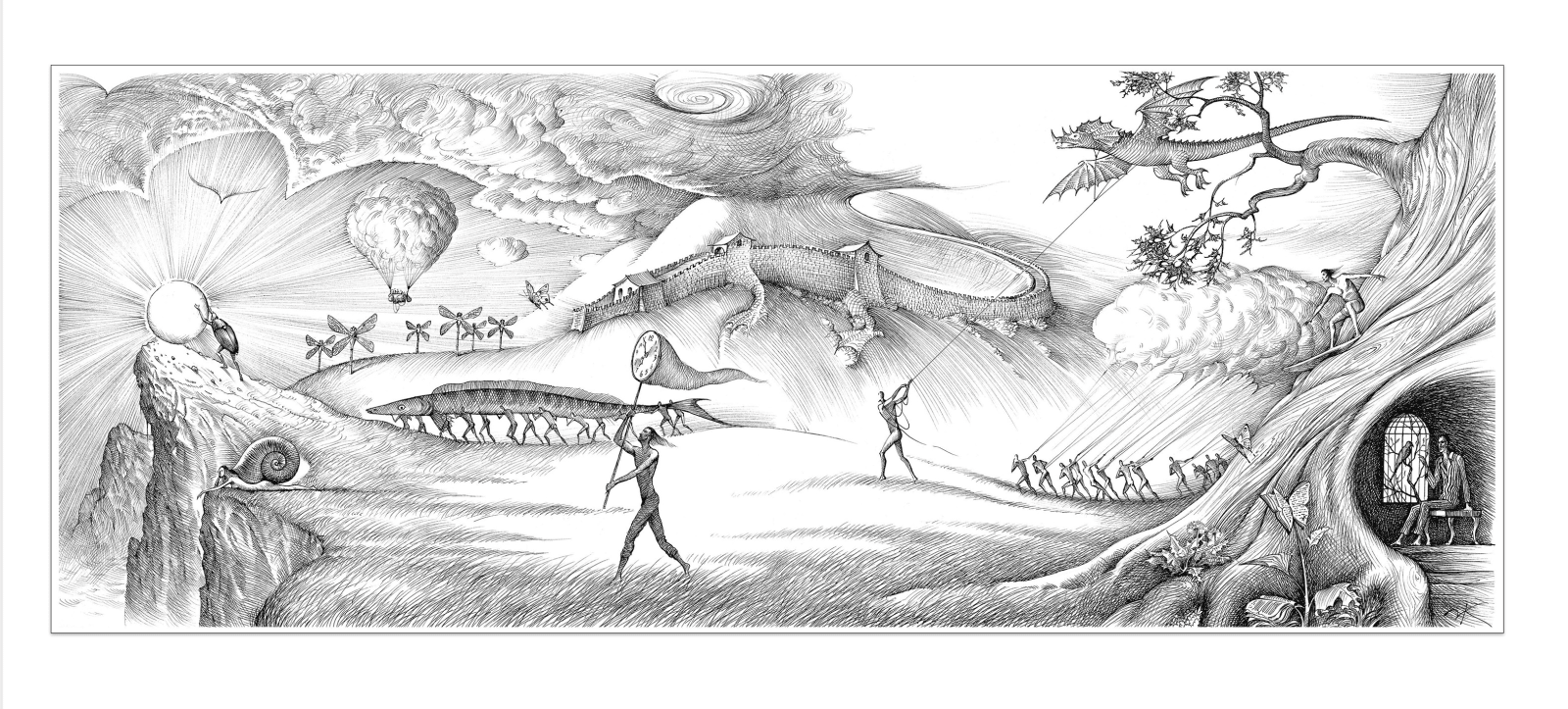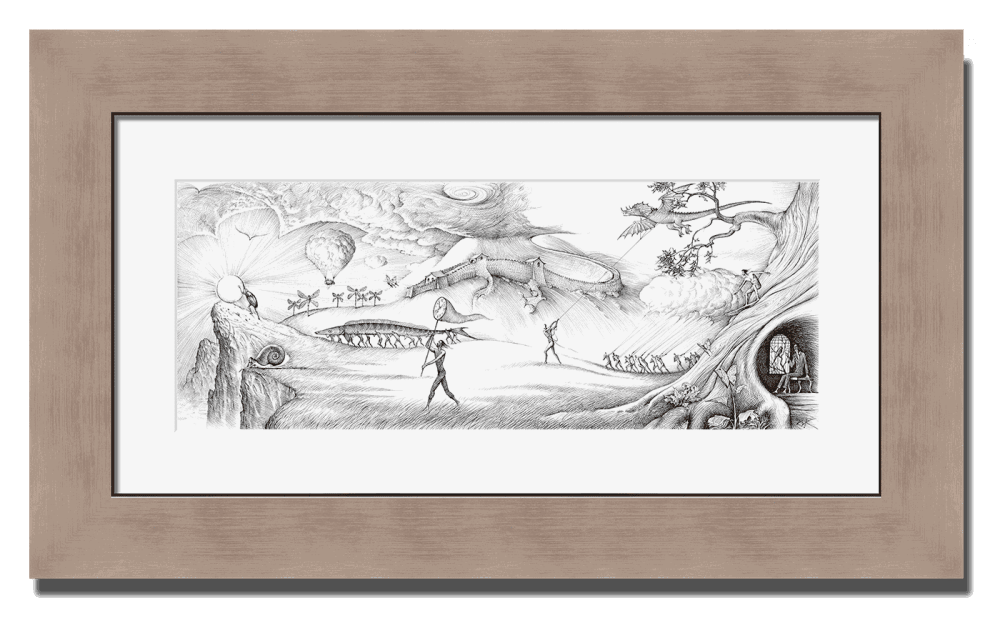HUMAN WAY
The task of the artist is to represent his creative journey. In our ever-changing world this is achieved through metaphor. Such a representation is like an electronic microscope making visible the tiniest items less than the lightwave length in size.
The artist discovers the connection between subordinate objects or ideas and it looks like building a bridge above a deep gulf initially dividing two very distant concepts. In this way, for example, an image transference uncovers the previously unseen connection between the windmill sails and the butterfly wings, the flowing water and the flow of fabric, the neck of a jar and the neck of a shirt and so on.
Another way of representing the artist’s journey is through a script, a series of episodes, each having a designated place on a timeline ‘from dusk till dawn’. Every episode contains symbolic ideas reflecting the spiritual legacy of humankind, the thoughts and feelings shared by all human beings.
Those primary perceptions are genetically formed and a result of human evolution. Jung called them archetypes of human consciousness.
NB The movement along the symbolic Human Way in the painting is from right to left.
Episodes
- The starting point of the ‘human way’. Here a man talks to the parrot sitting in a cage. A caged bird is a metaphor of budging thought ‘struggling like a bird’ in a human skull (see Plato). The dialogue with the bird is essentially a person’s contemplation about his life and fate. It is conducted in the darkness of solitude in a heart-to-heart conversation. This ‘parrot point’ in the painting can be regarded as ‘zero’ on the time scale.
- The person, like Time itself, cannot stop. In other words, the ‘arrow of time’ always points in one direction. Life is a current that, once entered, is taking you along, sometimes carrying you ‘off and away’. The surfer in the painting is drawn into the overall flow and is part of it. We see the lines and patterns on the tree characteristic of ‘dangerous whirlpools’ negotiated by him.
- The downward movement follows the current of the tree from the top to the roots. We know that the growth rings and leaf patterns are formed by the flow of energy and the shores are shaped by the flowing waters. By analogy, the ‘flow of public consciousness’ transforms and determines our behavior. The tree itself can be referred tp as the ‘Tree of Life’. In the world mythology it is the basis of the whole universe. Its roots go deep into the soil and the top shoots forth to the skies, connecting Heaven and earth.
- Moving on to the left we see a cloud that can be called a ‘cloud of Destiny’ with the falling rain like ‘threads of fate’. In the ancient Greek mythology people’s lives are seen as threads the lengths of which (and thereby life spans) are measured by the sister deities Moirai and Parkaes.
- In the sky above the cloud there is a figure of the flying Dragon. In China a Dragon was a symbol of the ruling power. A tamed dragon can be regarded as representing an ‘intelligent or reasonable force’. Historically the Great Wall of China meant to protect Heavenly Empire against barbarians and was symbolically referred to as the “Dragon Defense”. According to this assigned role the wall in the painting takes the form of a stone dragon. It is worth noting also that the commandment to ‘tame your dragons’ applies to any civilized individual.
- Above the Great Wall we notice a snow-white sea bird looking like a giant cloud. Some species of sea birds can live ‘up in the skies’ for months without coming down to the ground. And since a bird has this heaven-reaching potential, it has long been regarded as a symbol of human soul. Being a ‘heavenly messenger’ it is in touch with divine spheres delivering word from above to people on earth (like the Dove of Annunciation).
- Further left following the S-shaped structure of the painting we encounter a scene that can be called “Fish Carriers”. We know from the history of religion that Christ himself was like a ‘fisherman’: an analogy between catching fish and converting people (in early Christian days the Greek word ΙΧΘΥΣ – “fish” – was used as an acronym for Ιησοῦς ΧριστόςΘεος Υἱός Σωτήρ (Jesus Christ, Son of God, Savior). The people being drawn towards water can be associated with the “collective unconscious” (according to Jung). It can be said that in the depths of the ocean there lies the knowledge hardly available (or perhaps unavailable) to men, but quite accessible to fish.
- At last, the final stop on the Human Way! We see a beetle pushing the sun disk up a cliff in order for it to drop down into the ocean – a reference to the myth about Sisyphus who is commanded by gods to roll a huge ball up a hill only for it to roll back again upon reaching the top.
According to certain mythological perceptions, the Sun goes down into the waters of the underworld in the West and moving to the East emerges anew in the morning (‘resurrection’). In the painting, this is reflected in diagonally interchanging positions of the Sun and the Moon (with a maximum distance between them).
PS. In graphic form, it can be viewed as the sun disk moving in parallel to the lower border of the painting.
- Observations
Consider the symbolism of the certain features in the painting:
- the windmill butterflies: butterfly – a symbol of immortality, as indicated in its life cycle from ‘life’ in the form of a bright green caterpillar through ‘death’ – the dark chrysalis – to the ‘resurrection’ of flying; those windmills can be the ones attacked by Don Quixote, the hero of the famous novel by Miguel de Cervantes;
- the “shell virgin” is a symbol of contemplation and withdrawing into one’s own world at the end of the day.
The structure of the painting
The symmetries that can be traced in this composition piece:
the S-shaped lines of the foreground forming the symbol of infinity ∞
diagonal symmetry in straight lines
the ‘snail’ – the ‘dragon’
the cage with a parrot – the ‘cloud-balloon’
the sequence of the ‘butterfly book’, the flying butterfly and the windmills
Overall, the stationary parts, as points of ‘contemplation’ in the painting, are related to the moving parts and those inner symmetries help to unite the different images in the painting into a single composition. This composition piece in its entirety is a symbolic representation of the most important stages or phases in the spiritual history of a person in the general flow of life.
- Tumblr
This website uses cookies
This site uses cookies to help make it more useful to you. Please contact us to find out more about our Cookie Policy.







